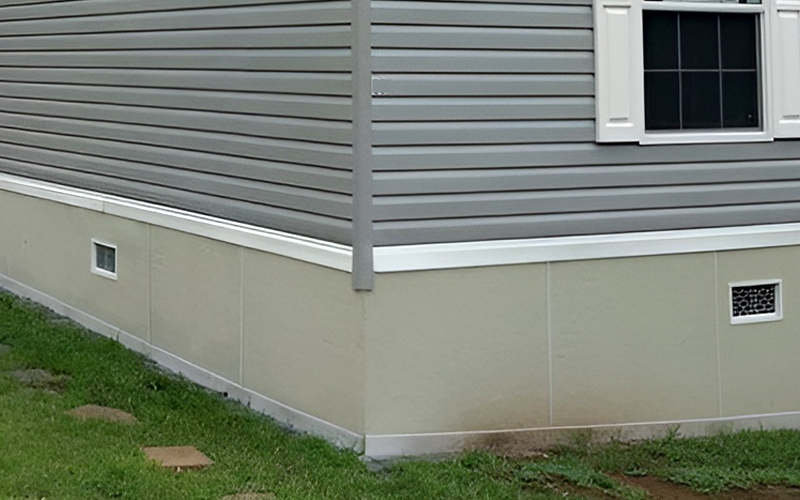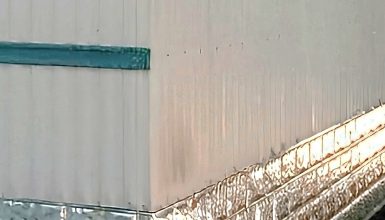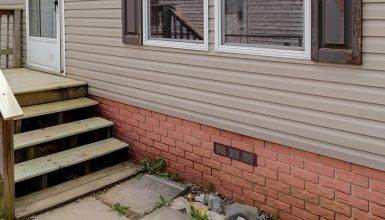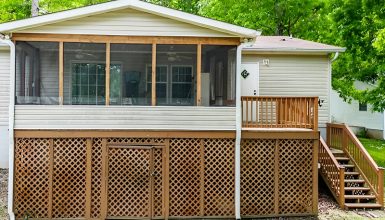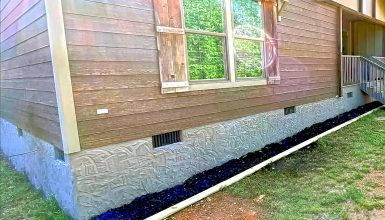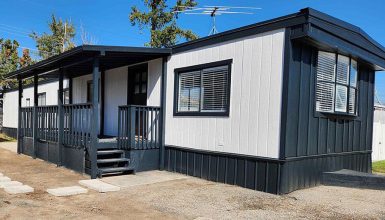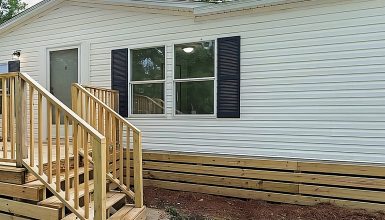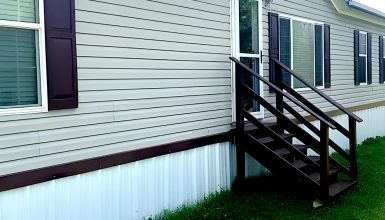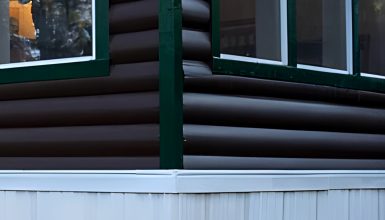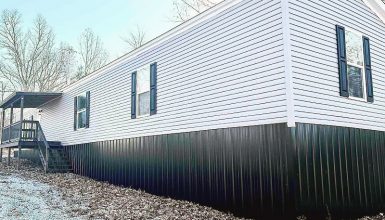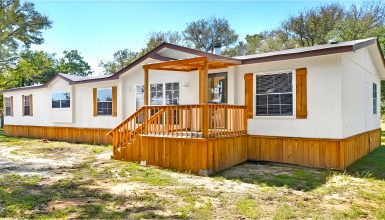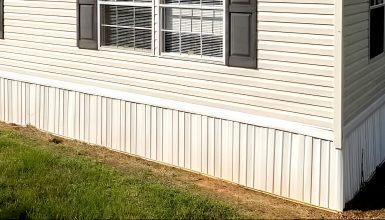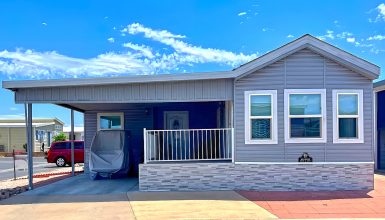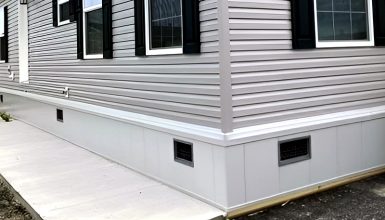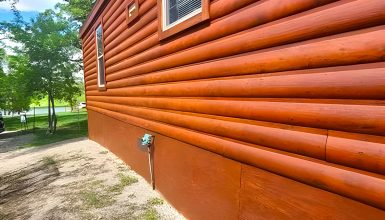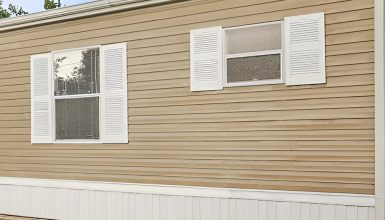Skirting is not just about aesthetics – though a well-chosen skirting can elevate your home’s curb appeal. It’s about protecting the underbelly of your home from the elements and pests and providing essential insulation. You’ve probably heard about the usual skirtings: vinyl, wood, or metal. But have you ever considered Hardie Board as an alternative for your mobile home skirting?
That’s right, Hardie Board. This sturdy material, known for its stellar performance as siding, is breaking into the mobile home skirting scene. So, buckle up, folks. We’re about to dive deeply into the world of Hardie Board. And find out if it might just be the alternative skirting material you’ve been searching for.
What is Hardie Board?
So, you’re probably wondering, “What exactly is Hardie Board?” It’s a great question and one that we’re excited to answer.
Hardie Board is a brand name synonymous with fiber cement siding. Picture a blend of sand, cement, and cellulose fibers, all mixed to create a super sturdy material. You know those incredibly durable building blocks you played with as a kid? Hardie Board is the grown-up version.
What sets Hardie Board apart is its resistance. It’s a bit like the Superman of siding materials. Water damage? It laughs in the face of it. Termites? Not on its watch. It’s even flame-resistant, making it a solid choice if safety is high on your priority list.
Now, despite its tough-guy image, Hardie Board isn’t all brawn. It also has a sophisticated side. It comes in various styles and colors, so whether you’re after a classic, wood-look finish or a sleek, modern vibe, there’s a Hardie Board for that.
In a nutshell, that’s Hardie Board. Tough, versatile, and a bit of a looker. But is it the right choice for your mobile home skirting? Stay tuned to find out.
Pros and Cons of Hardie Board for Mobile Home Skirting
Now that we’re all Hardie Board experts let’s dive into the nitty-gritty – the pros and cons of using it for mobile home skirting. Because let’s face it, every material has its ups and downs, and Hardie Board is no exception.
- Pros
Let’s start with the sunny side, the pros. We’ve already touched on this, but it bears repeating – Hardie Board is tough. It stands up to the weather like a champ, from blazing sun to freezing snow. So, this could be a win if you live in an area with four seasons. And remember how we said it’s resistant to water and pests? It means less worry about rot or insect damage, which is always a plus.
Now, for the aesthetics. Hardie Board can bring a lot of charm to your mobile home. It offers the look and feel of wood without the upkeep, and there’s a color palette to suit any style. Want a fresh, beachy vibe? Check. Prefer something rustic and warm? Check.
- Cons
But it’s not all roses with Hardie Board. There are a few cons we need to address. First up is cost. Hardie Board can be more expensive than other skirting materials. So it might not be the best fit for every budget. And while it’s durable, it isn’t invincible. It can crack or chip if it’s not handled carefully during installation.
Speaking of installation, it’s not exactly a walk in the park. Hardie Board is heavy and can be tough to install without professional help. So if you’re a DIY aficionado, you might need to call in some backup for this project.
There you have it – the good, the bad, and the Hardie. It’s a fantastic material, no doubt, but it’s not without its drawbacks. The key is to consider what works best for your home, climate, and budget. After all, the best choice is always the one that fits your unique needs.
How to Install Hardie Board Skirting on mobile home
Installing Hardie Board as skirting on your mobile home can be a DIY job if you’re confident with some basic tools.
Tools
First things first, you’re going to need some tools. We’re talking about a circular saw for cutting, a drill for screwing the boards into place, and safety gear because safety comes first. You might also need a helping hand. Hardie Board is heavy, and having a buddy around could make the job smoother.
Step-by-Step to Install Hardie Board Skirting
Here’s a simplified step-by-step guide to get you started. Remember always to follow the manufacturer’s instructions for the best results.
Step 1: Preparation
Begin by ensuring the area around the base of your mobile home is clear and ready for installation.
Step 2: Measure and Plan
Measure the perimeter of your mobile home where you will install the skirting. Also, measure the height from the ground to the bottom edge of your mobile home to determine the width of your skirting.
Step 3: Create the Frame
You need a sturdy framework to support the Hardie Board. Install a top and bottom track around the perimeter of your home. The bottom track should be installed onto the ground using suitable fasteners. And you should secure the top track to the home. These tracks provide a secure space for the Hardie Board to sit in.
Step 4: Cut the Hardie Board
Based on your measurements, cut the Hardie Board to size using a circular saw with a blade designed for cutting fiber cement. Remember to wear safety gear, including a dust mask, safety glasses, and gloves.
Step 5: Install the Hardie Board
Starting at a corner, slide the cut Hardie Board into the bottom track and push it up into the top track. Secure it with suitable screws. Repeat this step around the perimeter of your mobile home, ensuring each board fits snugly against the last.
Step 6: Seal the Seams
Once all Hardie Boards are installed, you may want to seal the seams between each board for a smoother appearance. Use a high-quality exterior-grade caulk for this.
Step 7: Paint (If Desired)
If you chose an unpainted Hardie Board, now’s the time to paint it. Use a paint recommended for fiber cement.
Step 8: Vent Installation
Don’t forget to install vents in the skirting for adequate airflow. You’ll typically need one square foot of venting for every 150 square feet of floor area in your home.
That’s it! While these are the basic steps, always consult the manufacturer’s guide for the specifics of your product. And if it sounds like too big of a job, it might be best to hire a professional to ensure it’s done right.
Conclusion
Hardie Board certainly earns its stripes if durability, resistance to weather and pests, and good looks are high on your list. But keep in mind; it’s not a lightweight contender. It demands a sturdy frame and careful installation. Also, it might require a bigger chunk of your budget than other options. Thank you for reading!

